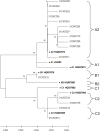Genetic variations and carcinogenicity analysis of E6/E7 oncogenes in HPV31 and HPV35 in Taizhou, China
- PMID: 39948614
- PMCID: PMC11827354
- DOI: 10.1186/s12985-025-02650-9
Genetic variations and carcinogenicity analysis of E6/E7 oncogenes in HPV31 and HPV35 in Taizhou, China
Abstract
Background: The purpose of this study was to investigate the genetic variations in the E6 and E7 oncogenes of HPV31 and HPV35, and to explore their potential role in cervical cancer risk among women in Taizhou, China.
Methods: Cervical exfoliated cells were collected for HPV genotyping, and only patients with a single infection of either HPV31 or HPV35 were selected for this study. The ABI 3730xl sequencer was utilized to sequence the E6 and E7 genes, followed by subsequent sequence alignment, analysis of genetic heterogeneity, and construction of maximum likelihood phylogenetic trees for the sequences of HPV31 and HPV35 using BioEdit and MEGA softwares.
Results: From 2013 to 2023, 148 HPV31 E6/E7 gene sequences and 121 HPV35 E6/E7 gene sequences were successfully obtained. We identified 16 distinct HPV31 E6/E7 variants and 5 distinct HPV35 E6/E7 variants, which have been deposited in GenBank under accession numbers OR540563-OR540578 and OR540579-OR540583, respectively. Phylogenetic analysis revealed that most of the HPV31 variants belonged to sublineage A2 (57.4%), followed by sublineages C2 (26.4%), C3 (14.2%) and B1 (2.0%). The proportion of CIN2 + patients in sublineage A2 was greater than that in other HPV31 sublineages, but the difference was not statistically significant (69.2% vs. 30.8%, P > 0.05). The most common variant in A2 was 31CNTZ07, which has a greater risk of CIN2 + than other A2 variants (OR = 3.5, 95% CI = 1.31 to 9.36; P < 0.05). In addition, all the HPV35 variants belonged to lineage A, of which 99.2% belonged to sublineage A1. 35CNTZ01 and 35CNTZ03 were the two most common HPV35 variants in our population, but no significant difference in their carcinogenic ability was observed (P < 0.05).
Conclusion: These data provides a deeper insight into the distribution of geographic/ethnical HPV31 and HPV35 variants, which contribute to the development of multivalent HPV vaccines and diagnostic assays that are suitable for Chinese women.
Keywords: Cervical cancer; E6/E7 oncogenes; Genetic variability; Human papillomavirus 31; Human papillomavirus 35; Phylogenetic analysis.
© 2025. The Author(s).
Conflict of interest statement
Declarations. Ethics approval and consent to participate: This study was approved by the Institutional Medical Ethics Review Board of Taizhou Hospital of Zhejiang Province (approval #K20220226), and was carried out in line with the Helsinki Declaration. All participants provided written informed consent for study participation before specimen collection, and the patients’ privacy is strictly protected. Consent for publication: Written informed consent was obtained from all patients for the publication of their medical data. Competing interests: The authors declare no competing interests.
Figures




Similar articles
-
Genetic variability in HPV 33 and 35 E6 and E7 genes from South African and Mozambican women with different cervical cytology status.Virol J. 2025 Jul 10;22(1):234. doi: 10.1186/s12985-025-02851-2. Virol J. 2025. PMID: 40640817 Free PMC article.
-
Study on the detection rate, genetic polymorphism, viral load, persistent infection capacity, and pathogenicity of human papillomavirus type 33.Virol J. 2025 Apr 26;22(1):121. doi: 10.1186/s12985-025-02752-4. Virol J. 2025. PMID: 40287740 Free PMC article.
-
Cervical carcinogenesis risk association of HPV33 E6 and E7 genetic variations in Taizhou, Southeast China.Virol J. 2023 Jul 19;20(1):156. doi: 10.1186/s12985-023-02125-9. Virol J. 2023. PMID: 37468974 Free PMC article.
-
Molecular epidemiology of human papillomavirus variants in cervical cancer in India.Indian J Med Res. 2024 Dec;160(6):531-551. doi: 10.25259/ijmr_212_24. Indian J Med Res. 2024. PMID: 39913513 Free PMC article.
-
Prophylactic vaccination against human papillomaviruses to prevent cervical cancer and its precursors.Cochrane Database Syst Rev. 2018 May 9;5(5):CD009069. doi: 10.1002/14651858.CD009069.pub3. Cochrane Database Syst Rev. 2018. PMID: 29740819 Free PMC article.
References
-
- Bray F, Laversanne M, Sung H, Ferlay J, Siegel RL, Soerjomataram I, et al. Global cancer statistics 2022: GLOBOCAN estimates of incidence and mortality worldwide for 36 cancers in 185 countries. Cancer J Clin. 2022;74(3):229–63. 10.3322/caac.21834 - PubMed
-
- Rahangdale L, Mungo C, O’Connor S, Chibwesha CJ, Brewer NT. Human papillomavirus vaccination and cervical cancer risk. BMJ. 2022;379:e070115. 10.1136/bmj-2022-070115 - PubMed
Publication types
MeSH terms
Substances
Supplementary concepts
Grants and funding
LinkOut - more resources
Full Text Sources
Miscellaneous

